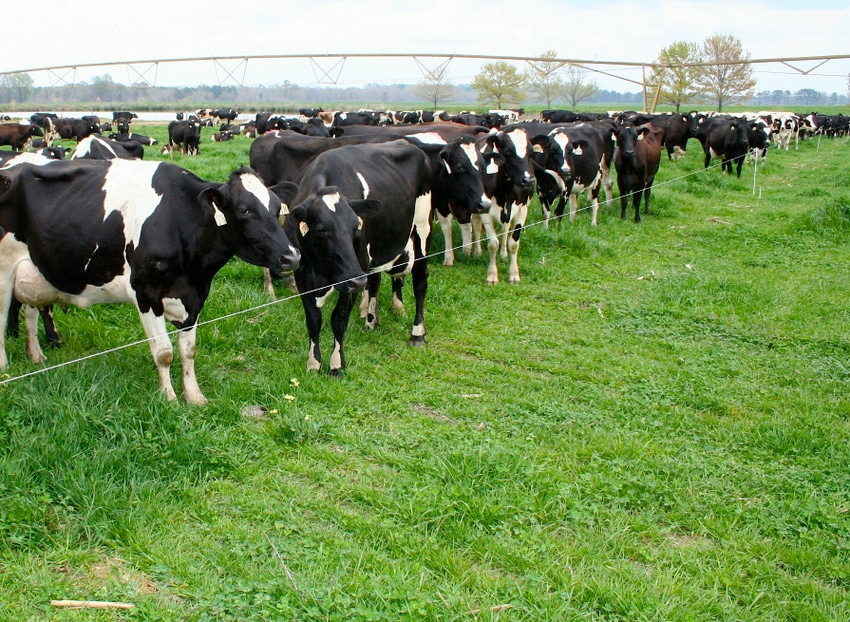May 15, 2014

Continuous grazing has been the traditional way to graze cattle over generations, but there may be a way to profitably improve your grazing system: rotational grazing .
Continuous grazing is when cattle graze a pasture for an extended amount of time with no, or infrequent rest to the plants from grazing. Advantages of this method are low fencing cost, low daily management requirements, and when stocking rate is correct, acceptable animal gains. This method is most effective where forage availability is plentiful and the manager does not wish to increase livestock numbers.
Continuous grazing is more successful when implemented with dry cows, bred heifers, and beef cows of moderate to low milking ability. When implemented with lactating dairy cattle, stocker calves, or other animals that require better quality forages, they may not perform to their potential.
One disadvantage of continuous grazing is the difficulty in controlling the timing and intensity of grazing. Another limitation of this system is during slow-forage-growth periods animal numbers need to be adjusted, or more acreage available for grazing. Continually grazing a pasture with too many animals will lead to reduced forage availability and quality and animal growth.
A continually grazed pasture will take longer to recover after a drought than a pasture that has been rested because the plants are more stressed. Another disadvantage to continuous grazing is the limited number of forages that can withstand the grazing pressure. Kentucky bluegrass and tall fescue are the two most popular grasses that can tolerate this grazing method and white clover is the only legume in Kentucky that has good stand survival under continuous grazing. Orchardgrass, red clover, and alfalfa are popular forages in KY, but stands of these species thin quickly under continuous grazing.
Rotational grazing is a system where a large pasture is divided into smaller paddocks allowing livestock to be moved from one paddock to the other easily. Using this method cattle are concentrated on a smaller area of the pasture for a few days then moved to another section of pasture. This movement allows the grazed paddock a rest period that permits forages to initiate regrowth, renew carbohydrate stores, and improve yield and persistency.
When utilized properly, rotational grazing can help farmers increase forage productivity. Rotational grazing can help improve productivity, weight gain or milk production per acre, and overall net return to the farm. Rotational grazing allows for better manure distribution that acts as a source of nutrients to the soil. Rotational grazing also has the potential to reduce machinery cost, fuel, supplemental feeding and the amount of forage wasted.
Extend the grazing season
The disadvantages of rotational grazing include the need for more fence to be constructed, time required to move cattle, and the need to have water and access to shade from each smaller paddock. The use of temporary fence is an inexpensive way to divide fields into the smaller paddocks and can be moved based upon the producers’ preference.
Rotational grazing can help extend the grazing season, allowing a producer to rely less on stored feed and supplement. One of the most desirable attributes of this system is that a producer can design it to fit their needs. Rotational grazing allows a producer to be more in control of the timing and intensity of forage grazed by cattle.
For those wanting to start using this system try taking one pasture and dividing it in half to begin with. If you see an improvement, divide it again the next year, or try dividing another pasture in half. For those who use this method it may take several years to figure out exactly what works best . Using temporary fence materials and portable watering tanks allows a producer to experiment with different paddock sizes and watering systems.
The type of grazing system that is best suited for a given farm will depend on the goal of the producer and their resources. Rotational grazing allows a producer a better opportunity to use livestock to manage grasses, legumes, and weeds. Continuous grazing requires less input and labor.
Increased area per animal is required as the season advances into the hot summer months, when pasture regrowth slows down. This can be done either by moving cattle to another paddock, often hay fields are cycled into grazing rotation after first cutting, or reducing herd numbers in a continually grazed system. The key to making a grazing system work is managing the balance between production and use of forage throughout the year. To learn more about managed grazing, and how it is effective, join us at one of our upcoming events.
You May Also Like




